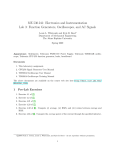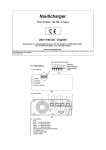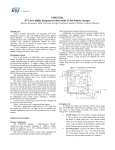Download Functional Module Report Gregory Crachiolo LM2901 Quad Voltage
Transcript
Functional Module Report Gregory Crachiolo USER MANUAL FOR THE LM2901 QUAD VOLTAGE COMPARATOR FUNCTIONAL MODULE LM2901 Quad Voltage Comparator 1 5/18/04 Functional Module Report Gregory Crachiolo TABLE OF CONTENTS 1. Index of Figures………………………………………………….………...3 2. Index of Tables………………………………………………….…………3 3. Introduction……………………………………………………….………. 4-5 4. Theory and Predictions……………...………………………….………... 5-6 5. Functional Module Description………………………………..………… 6 6. Wiring Instructions…………………………………………….………….7 7. LM2901 Chip Specifications……………………………………………... 7 8. LM2901 Connection Diagram…………………………………………….8 9. Apparatus ………………………………………………………….……... 8 10. Testing Sequence……………………………………………..……………8-9 11. List of Parts…………………………………………………….…….…….9 12. References……………………………………………………….….……... 10 LM2901 Quad Voltage Comparator 2 5/18/04 Functional Module Report Gregory Crachiolo Index of Figures Figure 1 Circuit Diagram for Basic Comparator Function………………..5 Figure 2 Comparator Chip Schematic………………………………………8 Figure 3 Comparator Connection Diagram………………………………...8 Index of Tables Table 1 Wiring Outline……………………………………………………..7 Table 2 Comparator Performance Features………………………………7 Table 3 Maximum Comparator Specifications……………………………7 Table 4 Functional Equipment List…………………………………….…..8 Table 5 Testing Sequence…………………………………………………...9 Table 6 Supply List………………………………….………………………9 Index of Images Picture 1 Comparator Module Construction……………………………….9 LM2901 Quad Voltage Comparator 3 5/18/04 Functional Module Report Gregory Crachiolo Introduction Comparators have many practical applications which mostly include implementation of instrumentation systems. However, comparators may also be used for timing and vibration. Many of the internal components of a voltage comparator are transistors. Every transistor has a base, emitter, and collector. The output of the comparator is connected to the collector of the last transistor in the chip. If a pull-up resistor is not connected to the output, the comparator will not function properly. This is called an open collector output. For the situation in this module, the input voltage is a DC signal. The purpose of the comparator circuit is to evaluate the difference between the input voltage and the reference voltage. In a comparator, different input voltages yield different outputs. For input voltages that are significantly larger than the reference voltage, the output voltage will be high—the LED will illuminate. For input voltages that are smaller than the reference voltage, the output of the comparator will be low—the LED will be off. For the purposes in this laboratory, the comparator becomes a light ‘switch.’ Comparators, however, are not mainly used for illumination. The LED serves as a tool to visualize what is happening. Without the LED, the output could still be quantified. However, an LED allows observation of the output without making specific measurements. For practical applications, a microcontroller is connected to the output from a comparator. The high or low voltage input to the microcontroller will cause different responses. LM2901 Quad Voltage Comparator 4 5/18/04 Functional Module Report Gregory Crachiolo +5 V Potentiometer Resistor (pull-up) 3k Ω V (in) +2.5 V Potentiometer V (ref) LED GND Figure 1. Circuit diagram for basic comparator function—module application Theory and Predictions The internal composition of a voltage comparator is, in essence, a modified operational amplifier (op-amp) circuit. A more detailed explanation of op-amps is provided in the corresponding module. An important note about op-amps is that they are integrated circuits. An integrated circuit is a collection of individual and electronic circuits that are composed on a single wafer. For the purposes of this module, a thorough discussion of these contents is not necessary. For a comparator application, as opposed to ground (in a non-inverting operational amplifier), a reference voltage is applied to the negative terminal. LM2901 Quad Voltage Comparator 5 5/18/04 Functional Module Report Gregory Crachiolo In this module, and for most applications, the reference voltage is held constant. The comparator allows a current to flow through the LED if the difference between the input voltage and the reference voltage has a quantity greater than zero. The value of the output voltage is dependent on the value of the voltage the pullup resistor is connected to, as well as the static value of the pull-up resistor. If the input voltage is less than the reference voltage, the current from the pull-up resistor will enter the comparator and flow to ground, thus leaving the LED turned off. Be careful: the current through the LED must not exceed its maximum capacity, or the LED will burn out. Also, when calculating the reference voltage theoretically, the voltage drop across the LED is approximately 1.7 V. Note: there is a buffer zone in which the comparator will not function if the input voltage is greater but very close to the reference voltage. Therefore, in order for the circuit to operate properly, there must be a significant difference between the two. For example: observe the experimental results (table 5)—for an input voltage .06 V above the reference voltage, the LED experiences no current. Functional Module Description The functional module consists of: the LM2901 Quad Voltage Comparator chip, a static resistor, two potentiometers, and one small light emitting diode (LED). The comparator chip requires a supply voltage (5 V) and ground (0 V), as well as the input and reference voltages. The potentiometers are used to vary the input voltage by changing its internal resistance so as to set the reference and input voltages. Resistors are used to protect the circuit, as well as vary the output. LM2901 Quad Voltage Comparator 6 5/18/04 Functional Module Report Gregory Crachiolo Wiring Instructions Table 1: Outline for circuit connections. Red Black Yellow Supply to the comparator, 5V Input to the potentiometers Supply to 3kΩ resistor Comparator to ground, 0V Potentiometers to ground LED to ground Potentiometers to input and reference terminals Output to resistor Resistor to LED LM2901 Chip Specifications Table 2: Comparator performance features. LM2901 Comparator Features Voltage Range Supply Current Drain Input Biasing Current Input Offset Current Offset Voltage Output Saturation Voltage 2-36 Vdc or ±1- ±18 Vdc .8 mA 25 nA ±5 nA ±3 mV 250 mV at 4 mA Table 3: Maximum comparator ratings. Absolute Maximum Ratings Supply Voltage Differential Input Voltage Storage Temperature Range Lead Temperature (soldering 10 sec) Operating Temperature Range LM2901 Quad Voltage Comparator 7 36 Vdc or ±18 Vdc 36 Vdc -65 °C to 150 °C 260 °C -40 °C to 85 °C 5/18/04 Functional Module Report Gregory Crachiolo LM2901 Connection Diagram Figure 2: Comparator chip layout. Figure 3: Comparator connection diagram Apparatus Table 4: Functional equipment list. Digital multimeter or equivalent voltmeter Power source Voltage box with 5V outlet and 0V ground Constructed comparator circuit box Testing Sequence Once the comparator is connected to a power supply, the circuit is ready for experimentation. The reference voltage is set at half of the supply voltage (2.5V). Connect the voltmeter to the input voltage and ground. Adjust the input voltage, while monitoring its level. Notice the voltage at which the LED illuminates—when the ‘switch’ is ‘on.’ A table representing these results is found in table 5. LM2901 Quad Voltage Comparator 8 5/18/04 Functional Module Report Gregory Crachiolo Table 5: Testing sequence results for a varying input voltage. V(ref) [Volts] 2.5 2.5 2.5 2.5 V(in) [Volts] 1 2.5 2.57 4 V(out) [Volts] 0.14 0.14 3.08 3.08 LED on? no no yes yes List of Parts Table 6: Comparator circuit supply list. Part LM2901 Quad Voltage Comparator Chip Pull-up Resistor Potentiometer LED Voltage Box Breadboard Red Wire Black Wire Yellow Wire Voltmeter Value N/A 3000 50,000 N/A 5 N/A N/A N/A N/A N/A Unit N/A Ω Ω N/A V N/A N/A N/A N/A N/A Picture 1: Comparator module construction LM2901 Quad Voltage Comparator 9 5/18/04 Functional Module Report Gregory Crachiolo References RIZZONI, GIORGIO. (2000) Principles and Applications of Electrical Engineering. 3rd Edition. Boston, MA. McGraw-Hill, 2000. National Semiconductor: LM2901 Comparator Data Sheet. http://cache.national.com/ds/LM/LM139.pdf LM2901 Quad Voltage Comparator 5/18/04 10
















